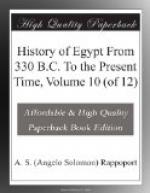It was under the government of Ptolemy that the wonders of Upper Egypt were first seen by any Greeks who had leisure, a love of knowledge, and enough of literature, to examine carefully and to describe what they saw. Loose and highly coloured accounts of the wealth of Thebes had reached Greece even before the time of Homer, and again through Herodotus and other travellers in the Delta; but nothing was certainly known of it till it was visited by Hecataeus of Abdera, who, among other works, wrote a history of the Hyperborean or northern nations, and also a history, or rather a description of Egypt, part of which we now read in the pages of Dio-dorus Siculus. When he travelled in Upper Egypt, Thebes, though still a populous city, was more thought of by the antiquary than by the statesman. Its wealth, however, was still great; and when, under the just government of Ptolemy, it was no longer necessary for the priests to hide their treasures, it was found that the temples still held the very large sum of three hundred talents of gold, and two thousand three hundred talents of silver, or above five million dollars, which had escaped the plundering hands of the Persian satraps. Many of the Theban tombs, which are sets of rooms tunnelled into the hills on the Libyan side of the Nile, had even then been opened to gratify the curiosity of the learned or the greediness of the conqueror. Forty-seven royal tombs were mentioned in the records of the priests, of which the entrances had been covered up with earth, and hidden in the sloping sides of the hills, in the hope that they might remain undisturbed and unplundered, and might keep safe the embalmed bodies of the kings till they should rise again at the end of the world; and seventeen of these had already been found out and broken open. Hecataeus was told that the other tombs had been before destroyed; and we owe it, perhaps, to this mistake that they remained unopened for more than two thousand years longer, to reward the searches of modern travellers, and to unfold to us the history of their builders.
The Memnonium, the great palace of Ramses II., was then standing; and though it had been plundered by the Persians, the building itself was unhurt. Its massive walls had scarcely felt the wear of the centuries which had rolled over them. Hecataaus measured its rooms, its courtyards, and its avenue of sphinxes; and by his measurements we can now distinguish its ruins from those of the other palaces of Thebes. One of its rooms, perhaps after the days of its builder, had been fitted up as a library, and held the histories and records of the priests; but the golden zodiac, or circle, on which were engraved the days of the year, with the celestial bodies seen to rise at sunrise and set at sunset, by which each day was known, had been taken away by Cambyses. Hecataaus also saw the three other palace-temples of Thebes, which we now call by the names of the villages in which they stand, namely, of Luxor, of Karnak, and of Medinet-Habu.




